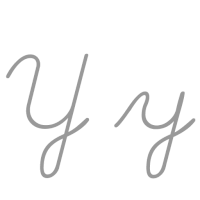Y
Y or y is the 25th and penultimate letter of the ISO basic Latin alphabet and the sixth vowel letter[1] of the modern English alphabet. In the English writing system, it sometimes represents a vowel and sometimes a consonant, and in other orthographies it may represent a vowel or a consonant. Its name in English is wye[2] (pronounced /ˈwaɪ/), plural wyes.[3]
| Y | |
|---|---|
| Y y | |
| (See below) | |
 | |
| Usage | |
| Writing system | Latin script |
| Type | Alphabetic and Logographic |
| Language of origin | Latin language |
| Phonetic usage | [y] [ɨ] [j] [iː] [ɪ] [ɘ] [ə] [ɯ] [ɛː] [ɥ] [ɣ̟] [ɛi] /waɪ/ /aɪ/ |
| Unicode value | U+0059, U+0079 |
| Alphabetical position | 25 |
| History | |
| Development | |
| Time period | 54 to present |
| Descendants | • U • V • W • Ỿ • ¥ • Ꮙ • Ꮍ • Ꭹ |
| Sisters | F Ѵ У Ў Ұ Ү ו و ܘ וּ וֹ ࠅ 𐎆 𐡅 ወ વ ૂ ુ उ |
| Variations | (See below) |
| Other | |
| Other letters commonly used with | y(x), ly, ny |
|
Name
In Latin, Y was named I graeca ("Greek I"), since the classical Greek sound /y/, similar to modern German ü or French u, was not a native sound for Latin speakers, and the letter was initially only used to spell foreign words. This history has led to the standard modern names of the letter in Romance languages – i grego in Galician, i grega in Catalan, i grec in French and Romanian, i greca in Italian – all meaning "Greek I". The names igrek in Polish and i gờ-rét in Vietnamese are both phonetic borrowings of the French name. In Dutch, both Griekse ij and i-grec are used. In Spanish, Y is also called i griega; however, in the twentieth century, the shorter name ye was proposed and was officially recognized as its name in 2010 by the Real Academia Española, although its original name is still accepted.[4] The original Greek name υ ψιλόν (upsilon) has also been adapted into several modern languages: in German, for example, it is called Ypsilon, in Icelandic it is ufsilon i, and in Italian the name is ipsilon or i greca. In Portuguese, both names are used (ípsilon and i grego).[5] In Faroese, the letter is simply called seinna i ("later i") because of its later place in the alphabet.
Old English borrowed Latin Y to write the native Old English sound /y/ (previously written with the rune yr ᚣ). The name of the letter may be related to 'ui' (or 'vi') in various medieval languages; in Middle English it was 'wi' /wiː/, which through the Great Vowel Shift became the Modern English 'wy' /waɪ/.
History
| Phoenician | Greek | Latin | English (approximate times of changes) | ||
|---|---|---|---|---|---|
| Old | Middle | Modern | |||
 |  | V → | U → | V/U/UU → | V/U/W |
| Y → | Y (vowel /y/) → | Y (vowel /i/) → | Y (vowels) | ||
 |  | C → | |||
| G → | Ᵹ (consonantal /g/, /j/ or /ɣ/) → | Ȝ (consonantal /g/, /j/ or /ɣ/) → | Y | ||
| Y (consonant) | |||||


The oldest direct ancestor of English letter Y was the Semitic letter waw (pronounced as [w]), from which also come F, U, V, and W. See F for details. The Greek and Latin alphabets developed from the Phoenician form of this early alphabet. In Modern English, there is also some historical influence from the old English letter yogh (Ȝȝ), which developed from the Semitic gimel (as described below).
Vowel
The form of the modern letter Y is derived from the Greek letter upsilon. The Romans first borrowed a form of upsilon – directly from the Greek alphabet, or from the Etruscan alphabet – as the single letter V, which represented both the vowel sound /u/ and the semivowel consonant sound /w/. (In modern written Latin, V is typically distinguished from U.) This first loaning of upsilon into Latin is not the source of the Modern English Y (instead, it is the source of Modern English U, V, and W).
The usage of the Greek Y form of upsilon as opposed to U, V, or W, dates back to the Latin of the first century BC, when upsilon was introduced a second time, this time with its "foot" to distinguish it. It was used to transcribe loanwords from the prestigious Attic dialect of Greek, which had the non-Latin vowel sound /y/ (as found in modern French cru (raw), or German grün (green)) in words that had been pronounced with /u/ in earlier Greek. Because [y] was not a native sound of Latin, it was usually pronounced /u/ or /i/. Some Latin words of Italic origin also came to be spelled with 'y': Latin silva ('forest') was commonly spelled sylva, in analogy with the Greek cognate and synonym ὕλη.[6]
The Roman Emperor Claudius proposed introducing a new letter (Ⱶ) into the Latin alphabet to transcribe the so-called sonus medius (a short vowel before labial consonants),[7] which in inscriptions was sometimes used for Greek upsilon instead.
The letter Y was used to represent the sound /y/ in the writing systems of some other languages that adopted the Latin alphabet. In Old English and Old Norse, there was a native /y/ sound, and so Latin U, Y and I were all used to represent distinct vowel sounds. But, by the time of Middle English, /y/ had lost its roundedness and became identical to I (/iː/ and /ɪ/). Therefore, many words that originally had I were spelled with Y, and vice versa. The distinction between /y/ and /i/ was also lost in later Icelandic and Faroese, making the distinction purely orthographic and historical, but not in the mainland Scandinavian languages, where the distinction is retained. It may be observed that a similar merger of /y/ into /i/ happened in Greek around the beginning of the 2nd millennium, making the distinction between iota (Ι, ι) and upsilon (Υ, υ) purely a matter of historical spelling there as well. In the West Slavic languages, Y was adapted as a sign for the close central unrounded vowel /ɨ/; later, /ɨ/ merged with /i/ in Czech and Slovak, whereas Polish retains it with the pronunciation [ɘ]. Similarly, in Middle Welsh, Y came to be used to designate the vowels /ɨ/ and /ɘ/ in a way predictable from the position of the vowel in the word. Since then, /ɨ/ has merged with /i/ in Southern Welsh dialects, but /ɘ/ is retained.
In Modern English, Y can represent the same vowel sounds as the letter I. The use of the letter Y to represent a vowel is more restricted in Modern English than it was in Middle and early Modern English. It occurs mainly in the following three environments: for upsilon in Greek loan-words (system: Greek σύστημα), at the end of a word (rye, city; compare cities, where S is final), and in place of I before the ending -ing (dy-ing, justify-ing).
Consonant
As a consonant in English, Y normally represents a palatal approximant, /j/ (year, German Jahr). This use was possibly influenced by the Middle English letter yogh (Ȝȝ), which could represent /j/. (Yogh could also represent other sounds, such as /ɣ/, which came to be written gh in Middle English.)
Confusion in writing with the letter thorn
When printing was introduced to Great Britain, Caxton and other English printers used Y in place of Þ (thorn: Modern English th), which did not exist in continental typefaces. From this convention comes the spelling of the as ye in the mock archaism Ye Olde Shoppe. But, in spite of the spelling, pronunciation was the same as for modern the (stressed /ðiː/, unstressed /ðə/). Pronouncing the article ye as yee (/jiː/) is purely a modern spelling pronunciation.[8]
Pronunciation and use
| Language | Dialect(s) | Pronunciation (IPA) | Environment | Notes |
|---|---|---|---|---|
| Afrikaans | /əi/ | |||
| Albanian | /y/ | |||
| Cornish | /i/ | Usually | ||
| /ɪ/ | Before multiple consonants | |||
| /j/ | Before vowels | |||
| Czech | /i/ | |||
| Danish | /ʏ/ | Before multiple consonants | ||
| /y/ | Usually | |||
| Dutch | /ɛi/ | Archaic spelling of <ij> | ||
| English | /aɪ/ | Usually | ||
| /i/ | After vowels | |||
| /ɪ/ | Unstressed; stressed before a consonant | |||
| /j/ | Before vowels | |||
| Faroese | /ɪ/ | Before two consonants | ||
| /ʊi/ | Usually | |||
| Finnish | /y/ | |||
| German | Alemannic | /iː/ | ||
| Standard | /j/ | In some words | ||
| /ʏ/ | Before two consonants | |||
| /y/ | Usually | |||
| Guaraní | /ɨ/ | |||
| Icelandic | /iː/ | |||
| /ɪ/ | ||||
| Lithuanian | /iː/ | |||
| Malagasy | /ɨ/ | |||
| Manx | /ə/ | |||
| Norwegian | /ʏ/ | Before multiple consonants | ||
| /y/ | Usually | |||
| Polish | /ɨ/ | |||
| Slovak | /i/ | |||
| Spanish | /i/ | Usually | ||
| /ɟʝ/ | Before vowels, word-initially | |||
| /ʝ/ | Before vowels | |||
| Swedish | /ʏ/ | Before multiple consonants | ||
| /y/ | USually | |||
| Turkmen | /ɯ/ | |||
| Vietnamese | /i/ | |||
| Welsh | Northern | /ɨ/ | ||
| Southern | /i/ | |||
English
As /j/:
- at the beginning of a word as in yes
As non-syllabic [ɪ̯]:
- after some vowels in diphthongs, as in play, grey, boy
As /i/:
- without stress at the end of multi-syllable word as in baby, happy
- used in combination with e at the end of words, as in money, key
As /ɪ/:
- in a closed syllable without stress and with stress as in myth, system, gymnastics
- in a closed syllable under stress as in typical, lyric
- in an open syllable without stress as in physique, pyjamas
As /aɪ/:
- under stress in an open syllable as in my, type, rye, lying, pyre, tyre, typhoon
- in a stressed open syllable as in hyphen, cycle, cylon
- in a pretonic open syllable as in hypothesis, psychology
- word-finally after a consonant, as in ally, unify
Other:
- combining with ⟨r⟩ as /ɜːr/ under stress (like ⟨i⟩ in bird), as in myrtle, myrrh
- as /ə/ (schwa) in words like martyr
In English morphology, -y is an adjectival suffix.
Y is the ninth least frequently used letter in the English language (after P, B, V, K, J, X, Q, and Z), with a frequency of about 2% in words.
Other languages
⟨y⟩ represents the sounds /y/ or /ʏ/ (sometimes long) in the Scandinavian languages. It can never be a consonant (except for loanwords).
In Dutch and German, ⟨y⟩ appears only in loanwords and proper names.
In Dutch, it usually represents /i/. It may sometimes be left out of the Dutch alphabet and replaced with the ⟨ij⟩ digraph. In addition, ⟨y⟩ and ⟨ÿ⟩ are occasionally used instead of Dutch ⟨IJ⟩ and ⟨ij⟩, albeit very rarely.
In German orthography, the pronunciation /yː/ has taken hold since the 19th century in classical loanwords – for instance in words like typisch /ˈtyːpɪʃ/ 'typical', Hyäne, Hysterie, mysteriös, Syndrom, System, Typ. It is also used for the sound /j/ in loanwords, such as Yacht (variation spelling: Jacht), Yak, Yeti; however, e.g. yo-yo is spelled "Jo-Jo" in German, and yoghurt/yogurt/yoghourt "Jog(h)urt" [mostly spelled with h]). The letter ⟨y⟩ is also used in many geographical names, e.g. Bayern Bavaria, Ägypten Egypt, Libyen Libya, Paraguay, Syrien Syria, Uruguay, Zypern Cyprus (but: Jemen Yemen, Jugoslawien Yugoslavia). Especially in German names, the pronunciations /iː/ or /ɪ/ occur as well – for instance in the name Meyer, where it serves as a variant of ⟨i⟩, cf. Meier, another common spelling of the name. In German the y is preserved in the plural form of some loanwords such as Babys babies and Partys parties, celebrations.
A ⟨y⟩ that derives from the ⟨ij⟩ ligature occurs in the Afrikaans language, a descendant of Dutch, and in Alemannic German names. In Afrikaans, it denotes the diphthong [əi]. In Alemannic German names, it denotes long /iː/, for instance in Schnyder [ˈʃniːdər] or Schwyz [ˈʃʋiːts] – the cognate non-Alemannic German names Schneider [ˈʃnaɪdər] or Schweiz [ʃʋaɪts] have the diphthong /aɪ/ that developed from long /iː/.
In Icelandic writing system, due to the loss of the Old Norse rounding of the vowel /y/, the letters ⟨y⟩ and ⟨ý⟩ are now pronounced identically to the letters ⟨i⟩ and ⟨í⟩, namely as /ɪ/ and /i/ respectively. The difference in spelling is thus purely etymological. In Faroese, too, the contrast has been lost, and ⟨y⟩ is always pronounced /i/, whereas the accented versions ⟨ý⟩ and ⟨í⟩ designate the same diphthong /ʊi/ (shortened to /u/ in some environments). In both languages, it can also form part of diphthongs such as ⟨ey⟩ (in both languages), pronounced /ei/, and ⟨oy⟩, pronounced /ɔi/ (Faroese only).
In French orthography, ⟨y⟩ is pronounced as [i] when a vowel (as in the words cycle, y) and as [j] as a consonant (as in yeux, voyez). It alternates orthographically with ⟨i⟩ in the conjugations of some verbs, indicating a [j] sound. In most cases when ⟨y⟩ follows a vowel, it modifies the pronunciation of the vowel: ⟨ay⟩ [ɛ], ⟨oy⟩ [wa], ⟨uy⟩ [ɥi]. The letter ⟨y⟩ has double function (modifying the vowel as well as being pronounced as [j] or [i]) in the words payer, balayer, moyen, essuyer, pays, etc., but in some words it has only a single function: [j] in bayer, mayonnaise, coyote; modifying the vowel at the end of proper names like Chardonnay and Fourcroy. In French ⟨y⟩ can have a diaresis (tréma) as in Moÿ-de-l'Aisne.
In Spanish, ⟨y⟩ was used as a word-initial form of ⟨i⟩ that was more visible. (German has used ⟨j⟩ in a similar way.) Hence, el yugo y las flechas was a symbol sharing the initials of Isabella I of Castille (Ysabel) and Ferdinand II of Aragon. This spelling was reformed by the Royal Spanish Academy and currently is only found in proper names spelled archaically, such as Ybarra or CYII, the symbol of the Canal de Isabel II. Appearing alone as a word, the letter ⟨y⟩ is a grammatical conjunction with the meaning "and" in Spanish and is pronounced /i/. As a consonant, ⟨y⟩ represents [ʝ] in Spanish. The letter is called i/y griega, literally meaning "Greek I", after the Greek letter ypsilon, or ye.
In Portuguese, ⟨y⟩ (called ípsilon in Brazil, and either ípsilon or i grego in Portugal) was, together with ⟨k⟩ and ⟨w⟩, recently reintroduced as the 25th letter, and 19th consonant, of the Portuguese alphabet, in consequence of the Portuguese Language Orthographic Agreement of 1990. It is mostly used in loanwords from English, Japanese and Spanish. Loanwords in general, primarily gallicisms in both varieties, are more common in Brazilian Portuguese than in European Portuguese. It was always common for Brazilians to stylize Tupi-influenced names of their children with the letter (which is present in most Romanizations of Old Tupi) e.g. Guaracy, Jandyra, Mayara – though placenames and loanwords derived from indigenous origins had the letter substituted for ⟨i⟩ over time e.g. Nictheroy became Niterói. Usual pronunciations are /i/, [j], [ɪ] and /ɨ/ (the two latter ones are inexistent in European and Brazilian Portuguese varieties respectively, being both substituted by /i/ in other dialects). The letters ⟨i⟩ and ⟨y⟩ are regarded as phonemically not dissimilar, though the first corresponds to a vowel and the latter to a consonant, and both can correspond to a semivowel depending on its place in a word.
Italian, too, has ⟨y⟩ (ipsilon) in a small number of loanwords. The letter is also common in some surnames native to the German-speaking province of Bolzano, such as Mayer or Mayr.
In Guaraní, it represents the vowel [ɨ].
In Polish, it represents the vowel [ɘ] (or, according to some descriptions, [ɨ̞]), which is clearly different from [i], e.g. my (we) and mi (me). No native Polish word begins with ⟨y⟩; very few foreign words keep ⟨y⟩ at the beginning, e.g. Yeti (pronounced [ˈjɛtʲi]).
In Czech and Slovak, the distinction between the vowels expressed by Y and I has been lost, but consonants before orthographic (and historical) Y are not palatalized, whereas they are before I.
In Welsh, it is usually pronounced [ə] in non-final syllables and [ɨ] or [i] (depending on the accent) in final syllables.
In the Standard Written Form of the Cornish Language, it represents the [ɪ] and [ɪː] of Revived Middle Cornish and the [ɪ] and [iː] of Revived Late Cornish. It can also represent Tudor and Revived Late Cornish [ɛ] and [eː] and consequently be replaced in writing with ⟨e⟩. It is also used in forming a number of diphthongs. As a consonant it represents [j].
In Finnish and Albanian, ⟨y⟩ is always pronounced [y].
In Estonian, ⟨y⟩ is used in foreign proper names and is pronounced as in the source language. It is also unofficially used as a substitute for ⟨ü⟩ and is pronounced the same as in Finnish.
In Lithuanian, ⟨y⟩ is the 15th letter and is a vowel. It is called the long i and is pronounced /iː/, like in English see.
When used as a vowel in Vietnamese, the letter ⟨y⟩ represents the sound /i/; when it is a monophthong, it is functionally equivalent to the Vietnamese letter ⟨i⟩. Thus, Mỹ Lai does not rhyme, but mỳ Lee does.<?----> There have been efforts to replace all such uses with ⟨y⟩ altogether, but they have been largely unsuccessful. As a consonant, it represents the palatal approximant. The capital letter ⟨Y⟩ is also used in Vietnamese as a given name.
In Aymara, Indonesian, Turkish, Quechua and the romanization of Japanese, Y is always a palatal consonant, denoting [j], as in English.
In Malagasy, the letter ⟨y⟩ represents the final variation of /ɨ/.
In Turkmen, ⟨y⟩ represents [ɯ].
In Washo, lower-case ⟨y⟩ represents a typical wye sound, while upper-case ⟨Y⟩ represents a voiceless wye sound, a bit like the consonant in English hue.
Other systems
In the International Phonetic Alphabet, ⟨y⟩ corresponds to the close front rounded vowel, and the related character ⟨ʏ⟩ corresponds to the near-close near-front rounded vowel.
The SI prefix for 1024 is yotta, abbreviated by the letter Y.
Related characters



Descendants and related characters in the Latin alphabet
- Y with diacritics: Ý ý Ỳ ỳ Ŷ ŷ Ÿ ÿ Ỹ ỹ Ẏ ẏ Ỵ ỵ ẙ Ỷ ỷ Ȳ ȳ Ɏ ɏ Ƴ ƴ
- ʎ and ʏ are used in the International Phonetic Alphabet
- U+AB5A ꭚ LATIN SMALL LETTER Y WITH SHORT RIGHT LEG is used in the Teuthonista phonetic transcription system[9]
- ʸ is used for phonetic transcription
- Ỿ ỿ : Y with loop is used by some Welsh medievalists to indicate the schwa sound of <y>[10]
Ancestors and siblings in other alphabets
- 𐤅: Semitic letter Waw, from which the following symbols originally derive
- Υ υ : Greek letter Upsilon, from which Y derives
- Ⲩ ⲩ : Coptic letter epsilon/he (not to be confused with the unrelated Greek letter Ε ε called epsilon)
- 𐌖 : Old Italic U/V, which is the ancestor of modern Latin V and U
- 𐍅 : Gothic letter uuinne/vinja, which is transliterated as w
- У у : Cyrillic letter U, which derives from Greek upsilon via the digraph omicron-upsilon used to represent the sound /u/
- Ѵ ѵ : Cyrillic letter izhitsa, which derives from Greek upsilon and represents the sounds /i/ or /v/. This letter is archaic in the modern writing systems of the living Slavic languages, but it is still used in the writing system of the Slavic liturgical language Church Slavonic.
- Ү ү : Cyrillic letter Ue (or straight U)
- Ұ ұ : Kazakh Short U
- Υ υ : Greek letter Upsilon, from which Y derives
Derived signs, symbols and abbreviations
- ¥ : Yen sign
- ⓨ : In Japan, ⓨ is a symbol used for resale price maintenance.
Computing codes
| Preview | Y | y | ||
|---|---|---|---|---|
| Unicode name | LATIN CAPITAL LETTER Y | LATIN SMALL LETTER Y | ||
| Encodings | decimal | hex | decimal | hex |
| Unicode | 89 | U+0059 | 121 | U+0079 |
| UTF-8 | 89 | 59 | 121 | 79 |
| Numeric character reference | Y | Y | y | y |
| EBCDIC family | 232 | E8 | 168 | A8 |
| ASCII[lower-alpha 1] | 89 | 59 | 121 | 79 |
On German typewriter and computer keyboards (in comparison to those used in the UK and US), the positions of the letters Y and Z are swapped. In German, Y is used mainly in loanwords and names.
Other representations
Notes
- Also for encodings based on ASCII, including the DOS, Windows, ISO-8859 and Macintosh families of encodings.
References
- "The Truth About 'Y': It's Mostly a Vowel". Merriam-Webster. Retrieved 14 July 2020.
- Also spelled wy, plural wyes.
- "Y", Oxford English Dictionary, 2nd edition (1989); Merriam-Webster's Third New International Dictionary of the English Language, Unabridged (1993); "wy", op. cit.
- Real Academia Española, ed. (2010). "Propuesta de un solo nombre para cada una de las letras del abecedario". Archived from the original on 2010-12-30.
- "Portuguese (Português)". Omniglot. Archived from the original on September 9, 2015. Retrieved May 12, 2016.
- Oxford English Dictionary Second edition, 1989; online version June 2011, s.v. 'sylva'
- Marotta, Giovanna (1999). "The Latin syllable". In van der Hulst, Harry; Ritter, Nancy A. (eds.). The Syllable: Views and Facts. p. 289. ISBN 3-11-016274-1.
- Burchfield, R.W., ed. (1996), "Ye", The New Fowler's Modern English Usage (3rd ed.), Oxford: Clarendon Press, p. 860
- Everson, Michael; Dicklberger, Alois; Pentzlin, Karl; Wandl-Vogt, Eveline (2011-06-02). "L2/11-202: Revised proposal to encode "Teuthonista" phonetic characters in the UCS" (PDF).
- Everson, Michael; Baker, Peter; Emiliano, António; Grammel, Florian; Haugen, Odd Einar; Luft, Diana; Pedro, Susana; Schumacher, Gerd; Stötzner, Andreas (2006-01-30). "L2/06-027: Proposal to add Medievalist characters to the UCS" (PDF).



